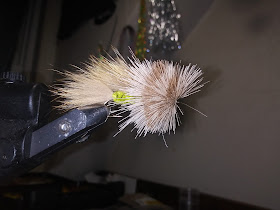Throughout the years, I've very infrequently delved into fly tying on this blog. That may partly because fly tying feels more like actual work to me than fishing does, but that's neither here nor there. Whatever the reason, I only occasionally have written actual fly tying posts, with recipes, tips, and productive patterns. And because I do routinely mention specific fly patterns, and have over the years simplified and honed my own fly selection down to relatively simple to tie but extremely effective patterns that can fool more than one species of fish, it's high time I started a fly tying series. Most of these flies, basically all of them, are other tyer's designs. A few are my own. But they all work, and I have an immense amount of faith in them. This series is not written for beginner tiers who are still learning simple methods and steps, but for experienced tiers looking to diversify their fly selection that can understand very simplified instructions that don't cover every step in detail. This is "Simple But Deadly".
Rich Garfield's "Sirloin" is a twist on the classic muddler. It's a three material streamer, very easy to tie, and I guarantee most of you that tie your own flies have two of the three necessary materials already. You may not have the third, but I highly recommend getting it if you want to tie the Sirloin. There are decent substitutes but I wouldn't call a sirloin without it's trademark wing an actual sirloin.
Recipe:
sz. 10 to sz. 1, 2x or 3x long streamer hook
Danville 3/0 waxed monocord white
Coyote belly fur
black, grey, brown, orange, olive, or white chenille
Deer hair
Tie in your chenille, wrap forward four to five turns, then tie off and trim (on hooks smaller than sz. 4, wrap chenille to just behind where the head would start. Hook sizes 4+ get 2 wing, under get one).
Tie in another clump of coyote fir, proportionally equivalent to the first.
Tie in your chenille again, and advance it four to five turns again, then tie off and trim.
Tie in a second wing of coyote fur, proportional to the first.
Trim and stack a clump of deer hair, pinch down to the top of the hook, make too loose wraps, then tighten while continuing to hold the clump in place to for the collar.
Spin two or three more large clumps of deer hair to form the head.
Whip finish or do 5 half hitches.
Using a razor blade, trim the bottom of the head flat.
Then round the rest of it.
Use your scissors to get the head to the shape you prefer.
Adirondack guide and tyer Rich Garfield really hit the ball out of the park on this one, the coyote hair provides a great natural color blend and swims beautifully in the water. You can modify this fly by adding lead or no lead wire, wrapped or as a keel, or simply use split shot or a sinking line to get it down. Fished without any weight near or at the surface at night, early in the morning, late in the evening, or on cloudy days, the sirloin can draw fish up. Strip the Sirloin quickly through the shadow lines along the bank in the summer when trout aren't actively rising. When striped bass are on shrimp st night in the creeks, swing a sparse Sirloin in tandem with a flatwing. Twitch this fly along the bottom to fool smallmouth feeding on crayfish or madtoms. This is not the last of Rich's concoctions that will find itself in the "Simple But Deadly" series... oh no, there in at least one more worth delving into.
 |
| Sirloins ready for action. |
Until next time,
Fish for the love of fish.
Fish for the love of places fish live.
Fish for you.
Thank you to my Patrons; Erin, David, John, Elizabeth, Brandon, Christopher, Shawn, Mike, Sara, Leo, and Franky for supporting this blog on Patreon.












Beautiful fly and looks deadly. I have been tying up a few Muddler Minnows myself lately. Fished them today both with and without split shot, but got no hits. Which brings me to a question if you're inclined to answer it.
ReplyDeleteMost winters I catch a few fish, but this winter I can't even buy a hit the last four or five times out. Any advice on getting off of this skunk train I've been on?
Suffice to say, I have no idea why you aren't catching fish. I don't know where you're fishing, what you're fishing, how you're fishing or exactly when you're fishing....
DeleteAll I can say i, this is not a normal winter, days that would normally be warmer that the rest are some of the coldest an least productive, fish are not sitting in the same places they would most winters, and they aren't eating the same way. So don't treat it the same as you would any other winter.
This is great Rowan. Show us more.
ReplyDeleteTie, fish, write, conserve and photo on...
Plenty more to come
Delete